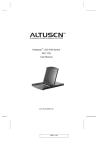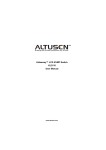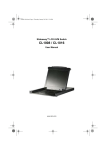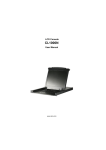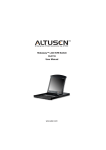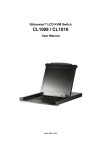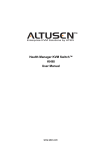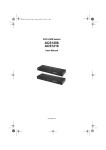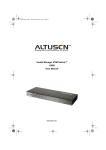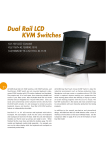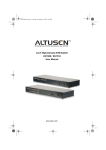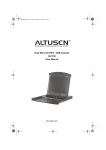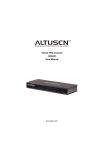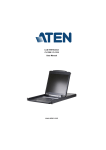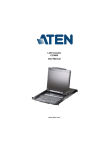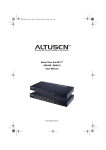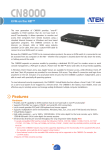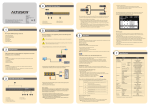Download OSD Operation
Transcript
LCD KVM Switch KL1116 User Manual www.aten.com KL1116 User Manual FCC, CE Information FEDERAL COMMUNICATIONS COMMISSION INTERFERENCE STATEMENT: This equipment has been tested and found to comply with the limits for a Class A digital device, pursuant to Part 15 of the FCC Rules. These limits are designed to provide reasonable protection against harmful interference when the equipment is operated in a commercial environment. This equipment generates, uses, and can radiate radio frequency energy and, if not installed and used in accordance with the instruction manual, may cause harmful interference to radio communications. Operation of this equipment in a residential area is likely to cause harmful interference in which case the user will be required to correct the interference at his own expense. FCC Caution: Any changes or modifications not expressly approved by the party responsible for compliance could void the user's authority to operate this equipment. CE Warning: This is a class A product. In a domestic environment this product may cause radio interference in which case the user may be required to take adequate measures. RoHS This product is RoHS compliant. SJ/T 11364-2006 The following contains information that relates to China. ii KL1116 User Manual User Information Online Registration Be sure to register your product at our online support center: International http://eservice.aten.com Telephone Support For telephone support, call this number: International 886-2-8692-6959 China 86-10-5255-0110 Japan 81-3-5615-5811 Korea 82-2-467-6789 North America 1-888-999-ATEN ext 4988 United Kingdom 44-8-4481-58923 User Notice All information, documentation, and specifications contained in this manual are subject to change without prior notification by the manufacturer. The manufacturer makes no representations or warranties, either expressed or implied, with respect to the contents hereof and specifically disclaims any warranties as to merchantability or fitness for any particular purpose. Any of the manufacturer's software described in this manual is sold or licensed as is. Should the programs prove defective following their purchase, the buyer (and not the manufacturer, its distributor, or its dealer), assumes the entire cost of all necessary servicing, repair and any incidental or consequential damages resulting from any defect in the software. The manufacturer of this system is not responsible for any radio and/or TV interference caused by unauthorized modifications to this device. It is the responsibility of the user to correct such interference. The manufacturer is not responsible for any damage incurred in the operation of this system if the correct operational voltage setting was not selected prior to operation. PLEASE VERIFY THAT THE VOLTAGE SETTING IS CORRECT BEFORE USE. iii KL1116 User Manual Package Contents Basic Package The KL1116 package consists of: 1 KL1116 HideawayTM LCD KVM Switch with Standard Rack Mounting Kit 2 Custom KVM Cable Sets 1 Firmware Upgrade Cable 1 Power Cord 1 User Manual* 1 Quick Start Guide 1 Registration Card Optional Equipment Depending on any optional equipment that you may have purchased, one of the following may be included in your package: Standard Rack Mounting Kit - Long Easy-Installation Rack Mounting Kit - Short Easy-Installation Rack Mounting Kit - Long Check to make sure that all of the components are present and in good order. If anything is missing, or was damaged in shipping, contact your dealer. Read this manual thoroughly and follow the installation and operation procedures carefully to prevent any damage to the switch or to any other devices on the KL1116 installation. * Features may have been added to the KL1116 since this manual was published. Please visit our website to download the most up to date version of the manual. Copyright © 2014 ATEN® International Co., Ltd. Manual Part No. PAPE-0253-2AXG Manual Date: 2014-02-27 Altusen and the Altusen logo are registered trademarks of ATEN International Co., Ltd. All rights reserved. All other brand names and trademarks are the registered property of their respective owners. iv KL1116 User Manual Contents FCC, CE Information. . . . . . . . . . . . . . . . . . . . . . . . . . . . . . . . . . . . . . . . . . ii SJ/T 11364-2006. . . . . . . . . . . . . . . . . . . . . . . . . . . . . . . . . . . . . . . . . . . . . ii User Information . . . . . . . . . . . . . . . . . . . . . . . . . . . . . . . . . . . . . . . . . . . . .iii Online Registration . . . . . . . . . . . . . . . . . . . . . . . . . . . . . . . . . . . . . . . .iii Telephone Support . . . . . . . . . . . . . . . . . . . . . . . . . . . . . . . . . . . . . . . .iii User Notice . . . . . . . . . . . . . . . . . . . . . . . . . . . . . . . . . . . . . . . . . . . . . .iii Package Contents. . . . . . . . . . . . . . . . . . . . . . . . . . . . . . . . . . . . . . . . . . . iv Basic Package. . . . . . . . . . . . . . . . . . . . . . . . . . . . . . . . . . . . . . . . . . . iv Optional Equipment . . . . . . . . . . . . . . . . . . . . . . . . . . . . . . . . . . . . . . . iv About This Manual . . . . . . . . . . . . . . . . . . . . . . . . . . . . . . . . . . . . . . . . . .viii Overview . . . . . . . . . . . . . . . . . . . . . . . . . . . . . . . . . . . . . . . . . . . . . . .viii Conventions . . . . . . . . . . . . . . . . . . . . . . . . . . . . . . . . . . . . . . . . . . . . ix Product Information. . . . . . . . . . . . . . . . . . . . . . . . . . . . . . . . . . . . . . . . . . ix Chapter 1. Introduction Overview . . . . . . . . . . . . . . . . . . . . . . . . . . . . . . . . . . . . . . . . . . . . . . . . . . . 1 Features . . . . . . . . . . . . . . . . . . . . . . . . . . . . . . . . . . . . . . . . . . . . . . . . . . . 3 Hardware Requirements . . . . . . . . . . . . . . . . . . . . . . . . . . . . . . . . . . . . . . . 4 Computers . . . . . . . . . . . . . . . . . . . . . . . . . . . . . . . . . . . . . . . . . . . . . . . 4 Cables . . . . . . . . . . . . . . . . . . . . . . . . . . . . . . . . . . . . . . . . . . . . . . . . . . 4 Front View . . . . . . . . . . . . . . . . . . . . . . . . . . . . . . . . . . . . . . . . . . . . . . . . . . 5 Rear View . . . . . . . . . . . . . . . . . . . . . . . . . . . . . . . . . . . . . . . . . . . . . . . . . . 7 Chapter 2. Hardware Setup Standard Rack Mounting. . . . . . . . . . . . . . . . . . . . . . . . . . . . . . . . . . . . . . . 9 Single Stage Installation . . . . . . . . . . . . . . . . . . . . . . . . . . . . . . . . . . . . . . 11 Daisy Chain Installation. . . . . . . . . . . . . . . . . . . . . . . . . . . . . . . . . . . . . . . 13 Chapter 3. Basic Operation Opening the Console . . . . . . . . . . . . . . . . . . . . . . . . . . . . . . . . . . . . . . . . 15 Opening Separately. . . . . . . . . . . . . . . . . . . . . . . . . . . . . . . . . . . . . . . 15 Opening Together . . . . . . . . . . . . . . . . . . . . . . . . . . . . . . . . . . . . . . . . 17 Operating Precautions. . . . . . . . . . . . . . . . . . . . . . . . . . . . . . . . . . . . . 18 Closing the Console . . . . . . . . . . . . . . . . . . . . . . . . . . . . . . . . . . . . . . . . . 19 Closing Separately . . . . . . . . . . . . . . . . . . . . . . . . . . . . . . . . . . . . . . . 19 Closing Together . . . . . . . . . . . . . . . . . . . . . . . . . . . . . . . . . . . . . . . . . 21 LCD OSD Configuration . . . . . . . . . . . . . . . . . . . . . . . . . . . . . . . . . . . . . . 22 The LCD Buttons . . . . . . . . . . . . . . . . . . . . . . . . . . . . . . . . . . . . . . . . . 22 LCD Adjustment Settings . . . . . . . . . . . . . . . . . . . . . . . . . . . . . . . . . . 23 Port Selection . . . . . . . . . . . . . . . . . . . . . . . . . . . . . . . . . . . . . . . . . . . . . . 24 Manual Port Switching. . . . . . . . . . . . . . . . . . . . . . . . . . . . . . . . . . . . . 24 v KL1116 User Manual Hot Plugging . . . . . . . . . . . . . . . . . . . . . . . . . . . . . . . . . . . . . . . . . . . . . . . 25 Switching Station Positions . . . . . . . . . . . . . . . . . . . . . . . . . . . . . . . . . 25 Hot Plugging Ports . . . . . . . . . . . . . . . . . . . . . . . . . . . . . . . . . . . . . . . 25 Powering Off and Restarting. . . . . . . . . . . . . . . . . . . . . . . . . . . . . . . . . . . 25 Port ID Numbering . . . . . . . . . . . . . . . . . . . . . . . . . . . . . . . . . . . . . . . . . . 26 Chapter 4. OSD Operation OSD Overview . . . . . . . . . . . . . . . . . . . . . . . . . . . . . . . . . . . . . . . . . . . . . 27 OSD Navigation . . . . . . . . . . . . . . . . . . . . . . . . . . . . . . . . . . . . . . . . . . . . 29 OSD Main Screen Headings. . . . . . . . . . . . . . . . . . . . . . . . . . . . . . . . . . . 29 OSD Functions . . . . . . . . . . . . . . . . . . . . . . . . . . . . . . . . . . . . . . . . . . . . . 30 F1 GOTO . . . . . . . . . . . . . . . . . . . . . . . . . . . . . . . . . . . . . . . . . . . . . . 30 F2 LIST . . . . . . . . . . . . . . . . . . . . . . . . . . . . . . . . . . . . . . . . . . . . . . . . 31 F3 SET . . . . . . . . . . . . . . . . . . . . . . . . . . . . . . . . . . . . . . . . . . . . . . . . 32 F4 ADM . . . . . . . . . . . . . . . . . . . . . . . . . . . . . . . . . . . . . . . . . . . . . . . . 34 F5 SKP . . . . . . . . . . . . . . . . . . . . . . . . . . . . . . . . . . . . . . . . . . . . . . . . 38 F6 BRC . . . . . . . . . . . . . . . . . . . . . . . . . . . . . . . . . . . . . . . . . . . . . . . . 38 F7 SCAN . . . . . . . . . . . . . . . . . . . . . . . . . . . . . . . . . . . . . . . . . . . . . . . 39 F8 LOUT . . . . . . . . . . . . . . . . . . . . . . . . . . . . . . . . . . . . . . . . . . . . . . . 40 Chapter 5. Keyboard Port Operation Invoking Hotkey Mode (HKM). . . . . . . . . . . . . . . . . . . . . . . . . . . . . . . . . . 41 When Hotkey Mode is active: . . . . . . . . . . . . . . . . . . . . . . . . . . . . 41 Hotkey Port Access . . . . . . . . . . . . . . . . . . . . . . . . . . . . . . . . . . . . . . . . . 42 Selecting the Active Port . . . . . . . . . . . . . . . . . . . . . . . . . . . . . . . . . . . 42 Auto Scanning. . . . . . . . . . . . . . . . . . . . . . . . . . . . . . . . . . . . . . . . . . . 43 Setting the Scan Interval . . . . . . . . . . . . . . . . . . . . . . . . . . . . . . . . 43 Invoking Auto Scan Mode . . . . . . . . . . . . . . . . . . . . . . . . . . . . . . . 44 Pausing Auto Scan: . . . . . . . . . . . . . . . . . . . . . . . . . . . . . . . . . . . . 44 Skip Mode . . . . . . . . . . . . . . . . . . . . . . . . . . . . . . . . . . . . . . . . . . . . . . 45 Beeper Control . . . . . . . . . . . . . . . . . . . . . . . . . . . . . . . . . . . . . . . . . . . . . 46 Hotkey Summary Table . . . . . . . . . . . . . . . . . . . . . . . . . . . . . . . . . . . . . . 46 Chapter 6. The Firmware Upgrade Utility Preparation . . . . . . . . . . . . . . . . . . . . . . . . . . . . . . . . . . . . . . . . . . . . . . . . 48 Starting the Upgrade. . . . . . . . . . . . . . . . . . . . . . . . . . . . . . . . . . . . . . . . . 49 Upgrade Succeeded . . . . . . . . . . . . . . . . . . . . . . . . . . . . . . . . . . . . . . 51 Upgrade Failed . . . . . . . . . . . . . . . . . . . . . . . . . . . . . . . . . . . . . . . . . . 52 Firmware Upgrade Recovery . . . . . . . . . . . . . . . . . . . . . . . . . . . . . . . . . . 52 Appendix Safety Instructions . . . . . . . . . . . . . . . . . . . . . . . . . . . . . . . . . . . . . . . . . . 53 General . . . . . . . . . . . . . . . . . . . . . . . . . . . . . . . . . . . . . . . . . . . . . . . . 53 vi KL1116 User Manual Rack Mounting . . . . . . . . . . . . . . . . . . . . . . . . . . . . . . . . . . . . . . . . . . 55 Consignes de sécurité. . . . . . . . . . . . . . . . . . . . . . . . . . . . . . . . . . . . . . . . 56 Général . . . . . . . . . . . . . . . . . . . . . . . . . . . . . . . . . . . . . . . . . . . . . . . . 56 Montage sur bâti . . . . . . . . . . . . . . . . . . . . . . . . . . . . . . . . . . . . . . . . . 59 Technical Support . . . . . . . . . . . . . . . . . . . . . . . . . . . . . . . . . . . . . . . . . . . 60 International. . . . . . . . . . . . . . . . . . . . . . . . . . . . . . . . . . . . . . . . . . . . . 60 North America . . . . . . . . . . . . . . . . . . . . . . . . . . . . . . . . . . . . . . . . . . . 60 Specifications . . . . . . . . . . . . . . . . . . . . . . . . . . . . . . . . . . . . . . . . . . . . . . 61 OSD Factory Default Settings . . . . . . . . . . . . . . . . . . . . . . . . . . . . . . . . . . 62 Connection Table . . . . . . . . . . . . . . . . . . . . . . . . . . . . . . . . . . . . . . . . . . . 62 Clear Login Information. . . . . . . . . . . . . . . . . . . . . . . . . . . . . . . . . . . . . . . 63 Optional Rack Mounting . . . . . . . . . . . . . . . . . . . . . . . . . . . . . . . . . . . . . . 64 Troubleshooting . . . . . . . . . . . . . . . . . . . . . . . . . . . . . . . . . . . . . . . . . . . . 68 Overview . . . . . . . . . . . . . . . . . . . . . . . . . . . . . . . . . . . . . . . . . . . . . . . 68 Dedicated Invocation Keys . . . . . . . . . . . . . . . . . . . . . . . . . . . . . . . . . . . . 68 About SPHD Connectors . . . . . . . . . . . . . . . . . . . . . . . . . . . . . . . . . . . . . 68 Limited Warranty . . . . . . . . . . . . . . . . . . . . . . . . . . . . . . . . . . . . . . . . . . . . 69 vii KL1116 User Manual About This Manual This User Manual is provided to help you get the most from your KL1116 system. It covers all aspects of installation, configuration and operation. An overview of the information found in the manual is provided below. Overview Chapter 1, Introduction, introduces you to the KL1116 System. Its purpose, features and benefits are presented, and its front and back panel components are described. Chapter 2, Hardware Setup, provides step-by-step instructions for setting up your installation, and explains some basic operation procedures. Chapter 3, Basic Operation, explains the fundamental concepts involved in operating the KL1116. Chapter 4, OSD Operation, provides a complete description of the KL1116 OSD (On Screen Display), and how to work with it. Chapter 5, Keyboard Port Operation, explains the concepts and procedures used to control the KL1116 from the keyboard. Chapter 6, The Firmware Upgrade Utility, explains how to use this utility to upgrade the KL1116’s firmware with the latest available versions. An Appendix, at the end of the manual provides technical and troubleshooting information. viii KL1116 User Manual Conventions This manual uses the following conventions: Monospaced Indicates text that you should key in. [] Indicates keys you should press. For example, [Enter] means to press the Enter key. If keys need to be chorded, they appear together in the same bracket with a plus sign between them: [Ctrl+Alt]. 1. Numbered lists represent procedures with sequential steps. ♦ Bullet lists provide information, but do not involve sequential steps. → Indicates selecting the option (on a menu or dialog box, for example), that comes next. For example, Start → Run means to open the Start menu, and then select Run. Indicates critical information. Product Information For information about all ATEN products and how they can help you connect without limits, visit ATEN on the Web or contact an ATEN Authorized Reseller. Visit ATEN on the Web for a list of locations and telephone numbers: International http://www.aten.com North America http://www.aten-usa.com ix KL1116 User Manual This Page Intentionally Left Blank x Chapter 1 Introduction Overview The KL1116 KVM Switch is a control unit that allows access to multiple computers from a single KVM (keyboard, monitor, and mouse), console. Before the development of the Master View, the only way to control multiple computer configurations from a single console was through a complex and costly network system. Now, with the KL1116, you can easily access multiple computers in a cost effective manner. A single KL1116 can control up to 16 computers. As many as 31 additional units can be daisy chained to each other, so that up to 512 (KL1116 + KH0116) computers can all be controlled from a single keyboard-monitor-mouse console. The KL1116 offers a space-saving, streamlined approach to KVM switch technology by integrating a keyboard, LCD monitor, and touchpad in a Hideaway™ housing. The LCD display is built into the cover; the keyboard and touchpad are built into the base. Slide the LCD and keyboard modules out; flip the cover up; and you are ready to go to work. When finished, flip the cover down and slide the modules away. The LCD module and keyboard module slide separately – you can see the video display, for example, while the keyboard and touchpad are conveniently out of the way. For further convenience, the Hideaway™ housing is slightly less than 1U high for easy installation and manipulation in a 1U rack. The KL1116 also features high density 15 pin connectors instead of the usual 25 pin connectors. This space-saving innovation allows a full, 16 port switch to be installed in a 1U system rack. Because of its modular design, the KVM section can be detached from the switch section. Your KL1116 investment is protected by an included Firmware Upgrade Utility. You can stay current with the latest functionality improvements by downloading firmware update files from our website as they become available, and using the utility to quickly and conveniently perform the upgrade. Setup is fast and easy; plugging cables into their appropriate ports is all that is entailed. Because the KL1116 intercepts keyboard input directly, there is no software to configure; no need to get involved in complex installation routines; nor any need to be concerned with incompatibility problems. 1 KL1116 User Manual Access to any computer connected to the installation is easily accomplished either by means of a powerful, mouse driven, OSD (On Screen Display) menu system, or by entering Hotkey combinations from the keyboard. A convenient Auto Scan feature also permits automatic scanning and monitoring of the activities of all computers running on the installation one by one. There is no better way to save time and money than with a KL1116 installation. By using the KL1116 with its Hideaway™ console to manage your installation, you: (1) eliminate the expense of having to purchase a separate keyboard, monitor, and mouse for each computer; (2) save all the space those extra components would take up; (3) save the space that a keyboard, monitor, and mouse would take with a standard KVM switch; (4) save on energy costs; and (5) eliminate the inconvenience and wasted effort involved in constantly moving from one computer to another. 2 Chapter 1. Introduction Features Integrated KVM console with 15" or 17" LCD monitor - in a Hideaway™ housing. Hideaway™ housing is slightly less than 1U - with top and bottom clearance for smooth operation in a 1U high system rack. LCD Monitor component can slide independently of the keyboard/ touchpad component Space saving technology - two consoles (one bus) control up to 16 computers. Daisy chain up to 31 additional units to control up to 512 computers from the switch's integrated Hideaway™ console. No software required - convenient computer selection via mouse driven intuitive On Screen Display (OSD) menus and Hotkeys. Auto Scan feature for monitoring user-selected computers. Broadcast support - commands from the keyboard can be broadcast to all available computers on the installation. Hot Pluggable - add or remove computers without having to power down the switch. Two level password security - only authorized users view and control the computers - up to four users plus an administrator with separate profiles for each. DDC Emulation of the LCD Monitor - VGA settings of every connected computer are automatically adjusted for optimal output to the LCD Monitor. Upgradable firmware. Supports Windows, Linux, Unix, Netware, AIX (RS6000), DOS 6.2 and higher. 3 KL1116 User Manual Hardware Requirements Computers The integrated LCD monitor's maximum resolution is 1024 x 768 (15") or 1280 x 1024 (17"). Make sure that none of the computer resolution settings exceed the LCD monitor's maximum resolution. Cables Substandard cables may damage the connected devices or degrade overall performance. For optimum signal integrity and to simplify the layout, we strongly recommend that you use the high quality CS Custom Cable sets described below: Function CS Part Number KVM Switch to KVM Switch (Daisy Chaining) 2L-1700 - 0.6 m 2L-1701 - 1.8 m KVM Switch to Computer (PS/2 Connection) 2L-5201P - 1.2 m 2L-5202P - 1.8 m 2L-5203P - 3.0 m 2L-5206P - 6.0 m KVM Switch to Computer (USB Connection) 2L-5202UP - 1.8 m 2L-5203UP - 3.0 m 2L-5206UP - 6.0 m Note: 1. The KL1116 does not support serial mice. You cannot use Serial-toPS/2 adapters with the cables. Attempts to do so will not work. 2. The KL1116 supports the installation of a local external console. If you install an external console and wish to extend the distance between it and the switch, CS Custom extender cables are available in various lengths. Contact your dealer for details. 4 Chapter 1. Introduction Front View 1 2 4 3 5 6 11 12 10 7 9 8 No. Component Description 1 Upper Handle Pull to slide the LCD module out; push to slide the module in. See item 7 in this table and Opening the Console, page 15 for more details on sliding the console in and out. 2 LCD Display After sliding the LCD module out, flip up the cover to access the LCD monitor. 3 LCD Controls Buttons to control the position and picture settings of the LCD display are located here. See The LCD Buttons, page 22, for details. (Continues on next page.) 5 KL1116 User Manual (Continued from previous page.) No. 4 Component Port Switches and Port LEDs Description Press a switch to bring the KVM focus to the computer attached to its corresponding port. See Manual Port Switching, page 24 for details. Two Port LEDs are built into the Port Switches. The one on the left is the On Line LED; the one on the right is the Selected Port LED: An On Line LED lights GREEN to indicate that the computer attached to its corresponding port is up and running. A Selected LED lights ORANGE to indicate that the computer attached to its corresponding port is the one that has the KVM focus. The LED is steady under normal conditions, but flashes when its port is accessed under Auto Scan Mode (see page 39). 5 Keyboard Standard 105-key keyboard. 6 Touchpad Standard mouse touchpad. 7 Lower Handle Pull to slide the keyboard and touchpad module out. See item 1 in this table and Opening the Console, page 15 for more details on sliding the console in and out. 8 Power LED Lights BLUE to indicate that the unit is receiving power. 9 Lock LEDs & Reset Switch The Num Lock, Caps Lock, Scroll Lock LEDs are located here. A Reset Switch is located just to the right of the Lock LEDs. Press this recessed switch in with a thin object to perform a system reset. 10 Release Catch These catches (one on each side of the keyboard) release the keyboard and touchpad module so you can slide it away. 11 Firmware Upgrade Section Firmware Upgrade Port: The Firmware Upgrade Cable that transfers the firmware upgrade data from the administrator's computer to the KL1116 plugs into this RJ-11 connector. Firmware Upgrade Switch: During normal operation this switch should be in the NORMAL position. (The Firmware Upgrade Utility, page 47 for more details.) 12 6 Rack Mounting Brackets The rack mounting brackets located at each corner of the unit secure the chassis to a system rack. See Standard Rack Mounting, page 9 for details. Chapter 1. Introduction Rear View 1 3 4 No. 2 5 Component Description 1 Daisy Chain Port When daisy chaining units, the cable plugs in here. 2 KVM Ports The cables that link to the computers plug in here. Note: The shape of these 15-pin connectors has been specifically modified so that only KVM cables designed to work with this switch can plug in (See Cables, page 4). Do NOT attempt to use ordinary 15 pin VGA connector cables to link these ports to the computers. 3 Power Socket This is a standard 3 prong AC power socket. The power cord from an AC source plugs in here. 4 Power Switch This is a standard rocker switch that powers the unit On and Off. 5 External Console Section For flexibility and convenience, the KL1116 supports an independent, external, KVM console. The external console's keyboard, monitor, and mouse cables plug in here. 7 KL1116 User Manual This Page Intentionally Left Blank 8 Chapter 2 Hardware Setup 1. Important safety information regarding the placement of this device is provided on page 53. Please review it before proceeding. 2. Make sure that power to all the devices you will be connecting up have been turned off. You must unplug the power cords of any computers that have the Keyboard Power On function. Standard Rack Mounting A standard rack mounting kit is provided with your KL1116. The kit enables the switch to be mounted in rack with a depth of 42–77 cm. L Brackets Side Mountng Brackets Note: 1. It takes two people to mount the switch: one to hold it in place; the other to screw it in. 2. The standard rack mounting kit does not include screws or cage nuts. If you need additional screws or cage nuts, contact your rack dealer. 9 KL1116 User Manual Optional mounting kits – including single person Easy Installation kits – are available with a separate purchase. See Optional Rack Mounting, page 64 for details. To rack mount the KL1116, do the following: 1. While one person positions the KL1116 in the rack and holds it in place, the second person loosely screws the front brackets to the rack. 2. While the first person still holds the KL1116 in place, the second person slides the L brackets into the KL1116's side mounting brackets from the rear until the bracket flanges contact the rack, then screws the L brackets to the rack. 3. After the L brackets have been secured, tighten the front bracket screws. Note: Allow at least 5.1 cm on each side for proper ventilation, and at least 12.7 cm at the back for the power cord and cable clearance. 10 Chapter 2. Hardware Setup Single Stage Installation In a Single Stage installation, there are no additional switches daisy chained down from the first unit. To set up a single stage installation, refer to the installation diagram on the next page (the numbers in the diagram correspond to the numbers of the installation steps), and do the following: 1. Plug your external console's keyboard, monitor, and mouse into the Console Ports located on the switch's rear panel. The ports are color coded and marked with an appropriate icon to indicate themselves. Note: This step is optional. 2. For each of the computers you are installing, use a KVM cable set (as described in the Cables section on page 4), to connect any available KVM Port to the computer's keyboard, video and mouse ports. Note: Ignore the daisy chain port at this time. It is only used when daisy chaining additional KH0116 units. Daisy chaining is described in the next section. 3. Use the Power cord provided with this package to connect the switch's Power Socket to an AC power source. 4. Power on the switch. 5. After the switch is powered on, power on the computers. 11 KL1116 User Manual Single Stage Installation Diagram 3 4 2 1 2 12 Chapter 2. Hardware Setup Daisy Chain Installation To control even more computers, up to 31 KH0116 units can be daisy chained down from the KL1116. Note: It would be unnecessarily wasteful and expensive to use KL1116 switches for daisy chaining since there is no point in having consoles on the chained switches. Therefore, KH0116 switches are used instead. The KH0116 is similar to the KL1116, except that it comes in a standard housing without the built in Hideaway™ console. As many as 512 computers can be controlled from the unit's integrated Hideaway™ console in a complete installation. A table showing the relation between the number of computers and the number of KH0116 units needed to control them is provided on page 62 in the Appendix. To set up a daisy chained installation, refer to the daisy chain installation diagram on the following page, and do the following: 1. Make sure that power to all the devices you will be connecting up has been turned off. 2. Use a daisy chain cable set (described in the Cables section on page 4) to connect the Chain Out port of the parent unit to the Chain In port of the child unit (First Station Out to Second Station In, Second Station Out to Third Station In, etc.). 3. Use KVM cable sets (described in the Cables section of the KH0116 User Manual), to connect any available KVM Port on the daisy chained switch to the keyboard, video and mouse ports of the computers you are installing. 4. Repeat the above steps for any additional KH0116 units you wish to add to the chain. 5. Power up the installation according to the following procedure: a) Power on the First Station (KL1116). Wait a few seconds for the unit to ascertain its Station ID. (Continues on next page.) 13 KL1116 User Manual (Continued from previous page.) b) Power up each daisy chained station on the installation in turn (Second Station, then Third Station, etc.). Each KH0116 has an LED display on its front panel to indicate its Station ID (the Station ID for the First Stage unit (KL1116) is 01, the ID for the Second Stage unit (the first KH0116) is 02, the ID for the Third Stage unit is 03, etc.). In each case, wait for the Station ID to be ascertained and displayed on the Station ID LED before plugging in the next Station. c) After all the stations are up, power on the computers. Daisy Chain Installation Diagram KL1116 KH0116 14 Chapter 3 Basic Operation Opening the Console The KL1116's console consists of two modules: An LCD display module located under the top cover, and a keyboard / touchpad module below the LCD module. The modules can either slide together, or independently. This allows you to have the LCD display available for viewing while the keyboard / touchpad module is conveniently out of the way when not in use. As a safety precaution, to keep the console from accidentally sliding out, it is locked into the In position. Before you can pull it out, you must release it by pushing the catches on the unit's front panel toward the center of the switch. Opening Separately 1. Release the LCD module by pulling the release catch into the handle as you pull the module toward you. Release Catch 15 KL1116 User Manual 2. Pull the top panel all the way out until it clicks into place. 3. Rotate the top panel all the way back to expose the LCD screen. 16 Chapter 3. Basic Operation 4. Reach underneath and pull the keyboard module all the way out until it clicks into place. Opening Together Refer to the diagrams in the Opening Separately section as you do the following: 1. Release the console by sliding the front panel catches toward the center and as you pull the bottom panel a few centimeters toward you. Once the console has been released, you can let go of the catches. 2. Pull the bottom panel all the way out until it clicks into place. 3. Pull the top panel all the way out until it clicks into place. 4. Rotate the top panel all the way back to expose the LCD screen. Note: Refer to the warning on the following page regarding placing excessive weight on the keyboard module. 17 KL1116 User Manual Operating Precautions The maximum load bearing capacity of the keyboard module is 30kg. Failure to heed the information below can result in damage to the keyboard module. RIGHT Rest your hands and arms lightly on the keyboard module as you work. WRONG! DO NOT lean your body weight on the keyboard module. DO NOT place heavy objects on the keyboard module. 18 Chapter 3. Basic Operation Closing the Console Closing Separately 1. Pull the release catches located on either side of the keyboard toward you to release the keyboard module, then slide the module slightly in. 2. Let go of the catches. Using the front handle, push the keyboard module all the way in until it clicks into place. 19 KL1116 User Manual 3. Rotate the LCD module all the way down, then pull and let go of the rear catches to release the LCD module 4. Using the front handle, push the module all the way in until it clicks into place. 20 Chapter 3. Basic Operation Closing Together 1. Rotate the LCD module all the way down, then pull and let go of the rear catches to release the LCD module. (See the diagram on page 20, step 3.) 2. Using the front handle, push the LCD module all the way in until it clicks into place. (See the diagram on page 20, step 4.) 3. There are keyboard module release catches located on the underside of the keyboard module (indicated by the triangular markings on the LCD module cover). Reach underneath the keyboard module; pull these catches toward you; and slide the module a few centimeters in. 4. Let go of the catches. Using the front handle, slide the keyboard module all the way in until it clicks into place. 21 KL1116 User Manual LCD OSD Configuration The LCD Buttons The LCD OSD allows you to set up and configure the LCD display. Four buttons are used to perform the configuration, as described in the table, below: Button MENU Function When you have not entered the LCD OSD Menu function, pressing this button invokes the Menu function, and brings up the Main Menu. When you have entered the LCD OSD Menu function, and have reached a setting choice with the navigation buttons, pressing this button brings up its adjustment screen. When navigating through the menus, this button moves you Right or Up. When making an adjustment, it increases the value. When navigating through the menus, this button moves you Left or Down. When making an adjustment, it decreases the value. EXIT When you have not entered the LCD OSD Menu function, pressing this button performs an auto adjustment. An auto adjustment automatically configures all the settings for the LCD panel to what the OSD considers their optimum values to be. When you have entered the LCD OSD Menu function, pressing this button exits the current menu and returns you to the previous menu. Use it to leave an adjustment menu when you are satisfied with the adjustment you made. When you are at the Main Menu, pressing this button exits the LCD OSD. 22 Chapter 3. Basic Operation LCD Adjustment Settings An explanation of the LCD OSD adjustment settings is given in the table below: Setting Explanation Brightness Adjusts the background black level of the screen image. Contrast Adjusts the foreground white level of the screen image. Phase If pixel jitter or horizontal line noise is visible on the display, your LCD may have the wrong phase setting. Adjust the phase setting to eliminate these problems. Clock If vertical banding is visible on the display, your LCD may have the wrong clock setting. Adjust the clock setting to eliminate vertical banding. H-Position Positions the display area on the LCD panel horizontally (moves the display area left or right). V-Position Positions the display area on the LCD panel vertically (moves the display area up or down). Color Temperature Adjusts the color quality of the display. You can adjust the warmth value, color balance, etc. The Adjust Color selection has a further submenu that lets you fine tune the RGB values. Language Selects the language that the OSD displays its menus in. OSD Duration Lets you set the amount of time the OSD displays on the screen. If there is no input for the amount of time you choose, the OSD display turns off. Reset Resets the adjustments on all menus and submenus to their factory default settings. Note: The Language setting does not return to the factory default, but remains at the one that you have set it to. 23 KL1116 User Manual Port Selection The KL1116 provides three port selection methods to access the computers on the installation: Manual, OSD (On Screen Display) menus, and Hotkey. OSD Operation is discussed in Chapter 4; Hotkey Port Selection is discussed in Chapter 5. Manual Port Switching Press a switch to bring the KVM focus to the computer attached to its corresponding port. Press buttons 1 & 2 simultaneously for two seconds to perform a keyboard and mouse reset. Press buttons 7 & 8 simultaneously for two seconds to invoke Auto Scan Mode (see page 39). 24 Chapter 3. Basic Operation Hot Plugging The KL1116 supports hot plugging - components can be removed and added back into the installation by unplugging their cables from the ports without the need to shut the unit down. In order for hot plugging to work properly, however, the procedures described below must be followed: Switching Station Positions You can switch station positions by simply unplugging from the old parent and plugging into a new one. After you do, in order for the OSD menus to correspond to the change, you must reset the Station IDs in the OSD. See RESET STATION IDS, page 36, for details. Hot Plugging Ports In order for the OSD menus to correspond to the change, you must manually reconfigure the OSD to reflect the new Port information. See the F3 SET (page 32) and F4 ADM (page 34), functions for details. Note: If you have shut down more than one station, power up the highest station first and work your way down to the lowest one. Powering Off and Restarting If it becomes necessary to Power Off one of the units, unplug its power cable from the rear panel. Before starting it back up you must do the following: 1. Shut down all the computers that are attached to it. Note: You must unplug the power cords of any computers that have the Keyboard Power On function. Otherwise the switch will still receive power from the computers. 2. Wait 10 seconds, then plug the Station back in. 3. After the Station is up, Power On the computers. Note: If you have shut down more than one station, power up the highest station first and work your way down to the lowest one. 25 KL1116 User Manual Port ID Numbering Each KVM port on a Master View installation is assigned a unique Port ID. The Port ID is made up of two parts: a Station Number, and a Port Number: The Station Number is a two digit number which reflects the switch's position in the daisy chain sequence. Note: 1. The first station KL1116 has a Station Number of 01. The first daisy chained unit (KH0116) has a Station Number of 02. The next daisy chained KH0116 has a Station Number of 03, etc. 2. The daisy chained KH0116’s have front panel LEDs that display their station IDs. The Port Number is a two digit number which reflects the port on the Station that the computer is connected to. The Station Number precedes the Port Number. Station and Port numbers from 1 - 9 are padded with a preceding zero, so they become 01 - 09. For example, a computer attached to Port 6 of Station 12 would have a Port ID of: 12-06. 26 Chapter 4 OSD Operation OSD Overview The On Screen Display (OSD) is a menu driven method to handle computer control and switching operations. All procedures start from the OSD Main Screen. To pop up the Main Screen, tap the OSD key (see Dedicated Invocation Keys, page 68), or tap the [Scroll Lock] key twice. Note: You can optionally change the OSD Hotkey from the Scroll Lock key to the Ctrl key, in which case you would tap [Ctrl] twice (see OSD HOTKEY, page 32). With this method, the Ctrl keys must be on the same side (both left, or both right). The OSD incorporates a two level (Administrator / User) password system. Before the OSD Main Screen comes up, a login dialog box appears that asks you to provide your username password. If the password function has been set, you must provide a valid username and password in order to access the OSD Main Screen. If this is the first time that the OSD is being run, or if the password function has not been set, simply press [Enter]. The OSD Main Screen comes up in Administrator Mode. In this mode, you have Administrator privileges, with access to all Administrator and User functions, and can set up operations (including password authorization for the future), as you would like. 27 KL1116 User Manual When you invoke the OSD, a screen similar to the one below appears: F1:GOTO F3:SET F2:LIST F4:ADM ADMINISTRATOR LIST:ALL SN PN QV 01 01 01 02 02 02 02 02 14 15 16 01 02 03 04 05 F5:SKP F6:BRC F7:SCAN X z F8:LOUT zz NAME ATEN INTL.CO. 1 ATEN INTL.CO. 2 ATEN INTL.CO. 3 FAX SERVER 1 FAX SERVER 2 WEB SERVER 1 WEB SERVER 2 MAIL SERVER 1 Note: 1. The diagram depicts the Administrator's Main Screen. The User Main Screen does not show the F4 and F6 functions, since they are reserved for the Administrator and can't be accessed by ordinary Users. 2. The OSD always starts in List view, with the highlight bar at the same position it was in the last time it was closed. 3. Only the ports that have been set accessible by the Administrator for the currently logged in User are visible (see SET ACCESSIBLE PORTS, page 36, for details). 28 Chapter 4. OSD Operation OSD Navigation To dismiss the menu, and deactivate the OSD, Click the X at the upper right corner of the OSD Window; or press [Esc]. To Logout, Click F8 or the ZZZ symbol at the top of the Main Screen, or press [F8]. To move up or down through the list one line at a time, Click the Up and Down Triangle symbols (ST) or use the Up and Down Arrow Keys. If there are more list entries than there is room for on the Main Screen, the screen will scroll. To move up or down through the list one screen at a time, Click the Up and Down Arrow symbols (ÏÐ), or use the [Pg Up] and [Pg Dn] keys. If there are more list entries than there is room for on the Main Screen, the screen will scroll. To bring the KVM focus to a port, Double Click it, or move the Highlight Bar to it then press [Enter]. After executing any action, you automatically go back to the menu one level above. OSD Main Screen Headings Heading Explanation SN-PN This column lists the Port ID numbers (see Port ID Numbering, page 26) for all the KVM ports on the installation. The simplest method to access a particular computer is to Click it, or move the Highlight Bar to it, then press [Enter]. QV If a port has been selected for Quick View scanning (see SET QUICK VIEW PORTS, page 36), an arrowhead displays in this column to indicate so. The computers that are powered on and are On Line have a Sun symbol in this column to indicate so. NAME If a port has been given a name (see EDIT PORT NAMES, page 35), its name appears in this column. 29 KL1116 User Manual OSD Functions OSD functions are used to configure and control the OSD. For example, you can: rapidly switch to any port; scan selected ports only; limit the list you wish to view; designate a port as a Quick View Port; create or edit a port name; or make OSD setting adjustments. To access an OSD function: 1. Either Click a Function Key field at the top of the Main Screen, or press a Function Key on the keyboard. 2. In the Submenus that appear make your choice either by Double Clicking it, or moving the Highlight Bar to it, then pressing [Enter]. 3. Press [Esc] to return to the previous menu level. F1 GOTO GOTO allows you to switch directly to a port either by keying in the port's Name, or its Port ID. To use the Name method, key in 1; key in the port's Name; then press [Enter]. To use the Port ID method, key in 2; key in the Port ID; then press [Enter]. Note: You can key in a partial Name or Port ID. In that case, the screen will show all the computers that the User has View rights to (see SET ACCESSIBLE PORTS, page 36), that match the Name or Port ID pattern, regardless of the current List settings (see F2 LIST, page 31, for details). To return to the OSD Main Screen without making a choice, press [Esc]. 30 Chapter 4. OSD Operation F2 LIST This function lets you broaden or narrow the scope of which ports the OSD displays (lists) on the Main Screen. Many of the OSD functions only operate on the computers that are listed on the Main Screen. The submenu choices and their meanings are given in the table below: Choice Meaning ALL Lists all of the ports on the installation. QUICK VIEW Lists only the ports that have been selected as Quick View Ports (see SET ACCESSIBLE PORTS, page 36). POWERED ON Lists only the ports that have their attached computers Powered On. QUICK VIEW + POWERED ON Lists only the ports that have been selected as Quick View Ports (see SET QUICK VIEW PORTS, page 36), and that have their attached computers Powered On. Double Click the choice you want, or move the Highlight Bar to it, then press [Enter]. An icon appears before the choice to indicate that it is the currently selected one. 31 KL1116 User Manual F3 SET This function allows the Administrator and each User to set up their own, individual, working environment. A separate profile for each is stored by the OSD and is activated according to the Username provided during Log In. To change a setting: 1. Double Click it; or move the highlight bar to it, then press [Enter]. 2. After you select an item, a submenu with further choices appears. To make a selection, either Double Click it; or move the Highlight Bar to it, then press [Enter]. An icon appears before the selected choice to indicate which one it is. The settings are explained in the following table: Setting OSD HOTKEY Function Selects which Hotkey activates the OSD function: [Scroll Lock] [Scroll Lock] or [Ctrl] [Ctrl] Since the Ctrl key combination may conflict with programs running on the computers, the default is the Scroll Lock combination. PORT ID DISPLAY POSITION Allows you to position where the Port ID appears on the monitor. The default is the upper left corner, but you can have it appear anywhere on the screen. Use the Mouse or the Arrow Keys plus Pg Up, Pg Dn, Home, End, and 5 (on the numeric keypad with Num Lock off), to position the Port ID display, then Click or press [Enter] to lock the position and return to the Set submenu. PORT ID DISPLAY DURATION Determines how long a Port ID displays on the monitor after a port change has taken place. The choices are: User Defined – which lets you select the amount of time (from 1–255 seconds); and Always On – which displays the Port ID at all times. If you select User Defined, key in the number of seconds, then press [Enter]. The default is 3 Seconds. A setting of 0 (zero) disables this function. (Continues on next page.) 32 Chapter 4. OSD Operation (Continued from previous page.) Setting Function PORT ID DISPLAY MODE Selects how the Port ID is displayed: the Port Number alone (PORT NUMBER); the Port Name alone (PORT NAME); or the Port Number plus the Port Name (PORT NUMBER + PORT NAME). The default is PORT NUMBER + PORT NAME. SCAN DURATION Determines how long the focus dwells on each port as it cycles through the selected ports in Auto Scan Mode (see F7 SCAN, page 39). Key in a value from 1–255 seconds, then press [Enter]. Default is 5 seconds; a setting of 0 disables the Scan function. SCAN/SKIP MODE Selects which computers will be accessed under Skip Mode (see F7 SCAN, page 39) and Auto Scan Mode (see F7 SCAN, page 39). Choices are: ALL – All the Ports which have been set Accessible (see SET ACCESSIBLE PORTS, page 36); QUICK VIEW – Only those Ports which have been set Accessible and have been selected as Quick View Ports (see SET QUICK VIEW PORTS, page 36); POWERED ON – Only those Ports which have been set Accessible and are Powered On; QUICK VIEW + POWERED ON – Only those Ports which have been set Accessible and have been selected as Quick View Ports and are Powered On. The default is ALL. SCREEN BLANKER If there is no input from the console for the amount of time set with this function, the screen is blanked. Key in a value from 1–30 minutes, then press [Enter]. A setting of 0 disables this function. The default is 0 (disabled). HOTKEY COMMAND MODE Enables / Disables the Hotkey Command function. If the hotkey combinations conflict with programs running on the computers, you may want to disable hotkey operation by turning Hotkey Command Mode Off. The default is ON, which allows hotkey operation of the switch. 33 KL1116 User Manual F4 ADM F4 is an Administrator only function. It allows the Administrator to configure and control the overall operation of the OSD. To change a setting Double Click it; or use the Up and Down Arrow Keys to move the highlight bar to it then press [Enter]. After you select an item, a submenu with further choices appears. Double Click the choice you want, or move the Highlight Bar to it then press [Enter]. An icon appears before the selected choice so that you know which one it is. The settings are explained in the following table: Setting Function SET USERNAME This function is used to set Usernames and Passwords for the AND Administrator and Users: PASSWORD 1. One Administrator and four User passwords can be set. 2. After you select the Administrator field or one of the User fields, a screen that allows you to key in your username and password appears. The username and password may be up to 15 characters long, and can consist of any combination of letters and numbers (A–Z, 0–9). 3. For each individual, key in the Username and Password, then press [Enter]. 4. To modify or delete a previous Username and/or Password, use the backspace key to erase individual letters or numbers. SET LOGOUT TIMEOUT If there is no input from the console for the amount of time set with this function, the Operator is automatically logged out. A log in is necessary before the console can be used again. This enables other Operators to gain access to the computers when the original Operator is no longer accessing them, but has forgotten to log out. To set the timeout value, key in a number from 1–180 minutes, then press [Enter]. If the number is 0 [zero], this function is disabled. Default is 0 (disabled). (Continues on next page.) 34 Chapter 4. OSD Operation (Continued from previous page.) Setting EDIT PORT NAMES Function To help remember which computer is attached to a particular port, every port can be given a name. This function allows the Administrator to create, modify, or delete port names. To Edit a port name: 1. Click the port you want, or use the Navigation Keys to move the highlight bar to it, then press [Enter]. 2. Key in the new Port Name, or modify/delete the old one. The maximum number of characters allowed for the Port Name is 15. Legal characters include: All alpha characters: a–z; A–Z All numeric characters: 0–9 + - / : . and Space Case does not matter; the OSD displays the Port Name in all capitals no matter how they were keyed in. 3. When you have finished editing, press [Enter] to have the change take effect. To abort the change, press [Esc]. RESTORE DEFAULT VALUES This function is used to undo all changes and return the setup to the original factory default settings (see OSD Factory Default Settings, page 62) - except for the Names settings that were assigned to the Ports, which are saved. CLEAR THE NAME LIST This function clears the port name list. ACTIVATE BEEPER Choices are Y (for Yes), or N (for No). When activated, the beeper sounds whenever a Port is changed, when activating the Auto Scan function (see F7 SCAN, page 39), or an invalid entry is made on an OSD menu. The default is Y (activated). (Continues on next page.) 35 KL1116 User Manual (Continued from previous page.) Setting SET QUICK VIEW PORTS Function This function lets the Administrator select which Ports to include as Quick View ports. To select/deselect a port as a Quick View Port, use the Navigation Keys to move the highlight bar to it, then press [Spacebar]. When a port has been selected as a Quick View Port, an arrowhead displays in the QV column of the LIST on the Main Screen to indicate so. When a port is deselected, the arrowhead disappears. If one of the Quick View options is chosen for the LIST view (see F2 LIST, page 31), only a Port that has been selected here will display on the List. If one of the Quick View options is chosen for Auto Scanning (see SCAN/SKIP MODE, page 33), only a Port that has been selected here will be Auto Scanned. The default is for no ports to be selected. SET ACCESSIBLE PORTS This function allows the Administrator to define User access to the computers on the installation on a Port-by-Port basis. For each User, select the target Port; then press [Spacebar] to cycle through the choices: F (Full access), V (View only), or blank. Repeat until all access rights have been set, then press [Esc]. The default is F for all users on all ports. Note: A blank setting means that no access rights are granted. The port will not show up on the User's LIST on the Main Screen. RESET STATION If you change the position of one of the Stations in the daisy chain, IDS the OSD settings will no longer correspond to the new situation. This function directs the OSD to rescan the Station positions of the entire installation and updates the OSD so that the OSD Station information corresponds to the new physical layout. Note: Only the Station Numbers get updated. Except for the Port Names, all Administrator settings (such as Set Accessible Ports, Set Quick View Ports, etc.), for all of the computers affected by the change, have to be manually redone. FIRMWARE UPGRADE In order to upgrade the KL1116's firmware (see The Firmware Upgrade Utility, page 47), you must first invoke Firmware Upgrade Mode with this setting. When you bring up this menu, the current firmware version levels display. Select Y to enable Firmware Upgrade Mode, or N to leave this menu without enabling it. (Continues on next page.) 36 Chapter 4. OSD Operation (Continued from previous page.) Setting SET PS/2 CLK MODE Function Select the target computer from the list, then use the spacebar to cycle through the choices: 0 PS/2 CLK delay = Off; ASIC filter = On 1 PS/2 CLK delay = On; ASIC filter = Off 2 PS/2 CLK delay = Off; ASIC filter = Off The default is 0. Unless a computer is experiencing problems, we recommend this setting. If you experience a problem with DELL Server 1655MC computers, select setting 1. SET CONSOLE MODE This setting selects which consoles (internal/external) are enabled: 0 Both consoles enabled 1 LCD console only 2 External console only Use the spacebar to cycle to the choice you want. The default is 0. 37 KL1116 User Manual F5 SKP This function enables you to easily skip backward or forward – switching the console focus from the currently active KVM port to the previous or next available one. The selection of computers to be available for Skip Mode switching is made with the Scan/Skip Mode setting under the F3 SET function (see page 32). When you are in Skip Mode, press [←] to switch to the previous computer in the list; press [→] to switch to the next computer in the list; press [↑] to switch to the last computer on the previous station in the list; press [↓] to switch to the first computer on the next station in the list. Note: When you Skip, you only Skip to the previous or next available computer that is in the Scan/Skip Mode selection (see SCAN/SKIP MODE, page 33). When the focus switches to a Port that has been selected for Scan/Skip Mode, a Left/Right Triangle symbol appears before its Port ID Display to indicate so. While Skip Mode is in effect, the console will not function normally. You must exit Skip Mode in order to regain control of the console. To exit Skip Mode, press [Spacebar] or [Esc]. F6 BRC F6 is an Administrator only function. Clicking the F6 field, or pressing [F6], invokes Broadcast (BRC) Mode. In Broadcast Mode, commands are sent from the console to all computers, whether directly connected to the first stage KL1116 or attached to a daisy chained KVM switch. This function is particularly useful for operations that need to be performed on multiple computers, such as performing a system wide shutdown, installing or upgrading software, etc. While BRC Mode is in effect, a Speaker symbol appears before the Port ID Display of the port that currently has the console focus. While BRC Mode is in effect, the mouse will not function normally. You must exit BRC Mode in order to regain control of the mouse. To exit BRC Mode, invoke the OSD (with the OSD Hotkey), then Click the F6 field, or press [F6], to turn BRC Mode off. 38 Chapter 4. OSD Operation F7 SCAN This function automatically switches among the available computers at regular intervals so that you can monitor their activity without having to take the trouble of switching manually. The selection of computers to be included for Auto Scanning is made with the Scan/Skip Mode setting under the F3 SET function (see page 33). The amount of time that the focus stays on each Port is set with the Scan Duration setting under the F3 SET function (see page 33). As each computer is accessed, an S appears in front of the Port ID display to indicate that it is being accessed under Auto Scan Mode. While you are in Auto Scan Mode, you can pause the scanning in order to keep the focus on a particular computer either by pressing P, or with a Left Click of the mouse. To resume scanning, press P or Left Click, again. See Invoking Auto Scan Mode, page 44, for further details. Note: Pressing almost any of the typewriter keys (letters, numbers, Enter, Esc, Spacebar, etc.), will resume scanning. To stop scanning and stay at a particular location, press [Spacebar] or [Esc] to exit Auto Scan Mode. If the scanning stops on an empty port, or one where the computer is attached but is powered Off, the monitor screen will be blank, and the mouse and keyboard will have no effect. Simply wait - after the Scan Duration time is up, the Scan function will move on to the next port. While Auto Scan Mode is in effect, the console will not function normally. You must exit Auto Scan Mode in order to regain control of the console. To exit Auto Scan Mode, press [Spacebar] or [Esc]. 39 KL1116 User Manual F8 LOUT Clicking the F8 field, or pressing [F8] logs you out of the OSD, and blanks the Console screen. This is different from simply deactivating the OSD when you are at the Main Screen by pressing [Esc]. With this function you must log in all over again to regain access to the OSD, whereas with [Esc], all you have to do to reenter the OSD is tap the OSD Hotkey. Note: 1. When you reenter the OSD after logging out, the screen stays blank except for the OSD Main Screen. You must input your password before you can continue. 2. If you reenter the OSD after logging out, and immediately use [Esc] to deactivate the OSD without having selected a port from the OSD menu, a Null Port message displays on the screen. The OSD Hotkey will bring up the OSD Main Screen. 40 Chapter 5 Keyboard Port Operation The KL1116 provides an extensive, easy-to-use, hotkey function that makes it convenient to control and configure your KVM installation from the keyboard. Note: The hotkey function must be enabled to use hotkey operations. See HOTKEY COMMAND MODE, page 33, for details. Invoking Hotkey Mode (HKM) All Hotkey operations begin by invoking Hotkey Mode (HKM). There are two methods to invoke HKM. The first is to tap the Hotkey key on the keyboard (See Dedicated Invocation Keys, page 68); the second, is as follows: 1. Hold down the Num Lock key 2. Press and release the minus key 3. Release the Num Lock key [Num Lock] + [-] When Hotkey Mode is active: The Caps Lock, and Scroll Lock LEDs flash in succession to indicate so. They stop flashing and revert to normal status when you exit HKM. A Command Line appears on the monitor screen. The command line prompt is the word Hotkey: in yellow text on a blue background. Hotkey information that you key in displays on the command line. Ordinary keyboard and mouse functions are suspended – only Hotkey compliant keystrokes and mouse clicks (described in the sections that follow), can be input. At the conclusion of some hotkey operations, you automatically exit hotkey mode. With some operations, you must exit manually. To exit HKM manually, press [Esc] or [Spacebar]. 41 KL1116 User Manual Hotkey Port Access Hotkey Port Access allows you to select which computer has the KVM focus directly from the keyboard. The KL1116 provides the following Hotkey Port Access features: Selecting the Active Port Auto Scan Mode Skip Mode Switching Selecting the Active Port Each KVM port on the KL1116 installation is assigned a unique Port ID (see Port ID Numbering, page 26). You can bring the KVM focus to any computer on the installation with a Hotkey combination that specifies the Port ID of the KVM Port that it is connected to. The steps involved are: 1. Invoke HKM (see page 41). 2. Key in the computer's Port ID The Port ID numbers display on the Command Line as you key them in. If you make a mistake, use [Backspace] to erase the wrong number. 3. Press [Enter] After you press Enter, the KVM focus switches to the computer associated with the specified Port ID, and you automatically exit Hotkey Mode. 42 Chapter 5. Keyboard Port Operation Auto Scanning Auto Scanning allows the automatic monitoring of computer activity instead of having to switch manually. Invoking Auto Scan Mode causes the KL1116 to switch the KVM focus among all the active KVM Ports that are accessible to the currently logged on user at regular intervals. (See SCAN/SKIP MODE, page 33, for information regarding accessible ports.) Setting the Scan Interval The amount of time Auto Scan dwells on each port is set with the Scan Duration setting of the OSD F3 SET function (see page 33). You can change the scan interval before activating Hotkey Auto Scanning, if you wish, with the following Hotkey combination: 1. Invoke HKM (see page 41). 2. Key in [T] [n] Where [T] is the letter T, and [n] is a number from 1–255 that represents the number of seconds the system dwells on a port before going on to the next. The letter T and the numbers display on the Command Line as you key them in. If you make a mistake, use [Backspace] to erase the wrong number. 3. Press [Enter] After you press Enter, you automatically exit Hotkey Mode, and are ready to invoke Auto Scanning. 43 KL1116 User Manual Invoking Auto Scan Mode To start Auto Scan Mode, key in the following hotkey combination: 1. Invoke HKM (see page 41). 2. Press [A]. After you press A, you automatically exit HKM; enter Auto Scan Mode; and Auto Scanning begins. To exit Auto Scan Mode, press [Esc] or [Spacebar], or Right Click. Auto Scanning stops when you exit Auto Scan Mode. Note: While Auto Scan Mode is in effect, ordinary keyboard and mouse functions are suspended - only Auto Scan Mode compliant keystrokes and mouse clicks can be input. You must exit Auto Scan Mode in order to regain normal control of the console. Pausing Auto Scan: While you are in Auto Scan Mode, you can pause the scanning in order to keep the focus on a particular computer either by pressing P or with a Left Click of the mouse. During the time that Auto Scanning is paused, the Command Line displays: Auto Scan: Paused. At times, pausing when you want to keep the focus on a particular computer can be more convenient than Exiting Auto Scan Mode because when you resume scanning, you start from where you left off, whereas when you exit Auto Scan Mode, you resume scanning from the beginning – with the very first computer on the installation. To resume Auto Scanning after Pausing, press P or Left Click, again. Scanning continues from where it left off. Note: Pressing almost any of the typewriter keys (letters, numbers, Enter, Esc, Spacebar, etc.), will resume scanning. 44 Chapter 5. Keyboard Port Operation Skip Mode This feature allows you to switch between computers in order to monitor them manually. You can dwell on a particular port for as long or as little as you like – as opposed to Auto Scanning, which automatically switches after a fixed interval. To invoke Skip Mode, key in the following Hotkey combination: 1. Invoke HKM (see page 41). 2. Key in [Arrow] Where [Arrow] refers to one of the Arrow keys. After you press [Arrow], you automatically exit HKM, and enter Skip Mode where you can switch ports as follows: ← Skips from the current port to the first accessible port previous to it. (See SCAN/SKIP MODE, page 33, for information regarding accessible ports.) → Skips from the current port to the next accessible port. ↑ Skips from the current port to the last accessible port of the previous Station. If you are at a port on the First Station you cycle backward to the last accessible port on the Last Station. ↓ Skips from the current port to the first accessible port of the next Station. If you are at a port on the Last Station you cycle forward to the first accessible port on the First station. Once you are in Skip Mode, you can keep on skipping by pressing the Arrow keys. You don't have to invoke HKM again. While Skip Mode is in effect, ordinary keyboard and mouse functions are suspended - only Skip Mode compliant keystrokes can be input. You must exit Skip Mode in order to regain normal control of the console. 3. To exit Skip Mode, press [Esc] or [Spacebar]. 45 KL1116 User Manual Beeper Control The Beeper can be hotkey toggled On and Off. To toggle the Beeper, do the following: 1. Invoke HKM (see page 41). 2. Press and release the [B] key. The Beeper toggles On or Off. The Command Line displays Beeper On or Beeper Off for one second; then the message disappears and you automatically exit Hotkey Mode. Hotkey Summary Table [Num Lock] + [-] [Port ID] [Enter] Switches the KVM focus to the computer that corresponds to that Port ID. [T] [n] [Enter] Sets the Auto Scan interval to n seconds – where n is a number from 1–255. [A] Invokes Auto Scan Mode. When Auto Scan Mode is in effect, press [P] or left-click the mouse to pause Auto Scanning. When Auto Scanning is paused, press any key or left-click the mouse to resume Auto Scanning. [←] Invokes Skip Mode and skips from the current port to the first previous accessible port. [→] Invokes Skip Mode and skips from the current port to the next accessible port. [↑] Invokes Skip Mode and skips from the current port to the last accessible port of the previous station. If you are at a port on the First Station you cycle backward to the last accessible port on the Last Station. [↓] Invokes Skip Mode and skips from the current port to the first accessible port of the next station. If you are at a port on the Last Station you cycle forward to the first accessible port on the First station. [B] Toggles the beeper on or off. Note: The brackets in the table above indicate keys you should press. Simply press the indicated keys, do not type the brackets. 46 Chapter 6 The Firmware Upgrade Utility The Windows-based Firmware Upgrade Utility (FWUpgrade.exe) provides a smooth, automated process for upgrading the KVM switch's firmware. The Utility comes as part of a Firmware Upgrade Package that is specific for each device. New firmware upgrade packages are posted on our web site as new firmware revisions become available. Check the web site regularly to find the latest packages and information relating to them. 47 KL1116 User Manual Preparation To prepare for the firmware upgrade, do the following: 1. From a computer that is not part of your KVM installation go to our Internet support site and choose the model name that relates to your device to get a list of available Firmware Upgrade Packages. 2. Choose the Firmware Upgrade Package you want to install (usually the most recent), and download it to your computer. 3. Use the Firmware Upgrade Cable (provided with this unit), to connect a COM port on your computer to the Firmware Upgrade Port of your switch. Note: On a daisy chained installation, the chained stations will automatically receive the upgrade via the daisy chain cables. 4. Shut down all of the computers – but not the Stations – on your KVM installation. 5. From your KVM switch console, bring up the OSD (see OSD Overview, page 27) and select the F4:ADM function. 6. Scroll down to FIRMWARE UPGRADE. Press [Enter], then press [Y] to invoke Firmware Upgrade Mode (see FIRMWARE UPGRADE, page 36). For your reference, the current firmware upgrade version displays on the screen. 48 Chapter 6. The Firmware Upgrade Utility Starting the Upgrade To upgrade your firmware: 1. Run the downloaded Firmware Upgrade Package file – either by double clicking the file icon, or by opening a command line and entering the full path to it. The Firmware Upgrade Utility Welcome screen appears: Note: The screens shown in this section are for reference only. The wording and layout of the actual screens put up by the Firmware Upgrade Utility may vary slightly from these examples. 2. Read and Agree to the License Agreement (enable the I Agree radio button). (Continues on next page.) 49 KL1116 User Manual (Continued from previous page.) 3. Click Next to continue. The Firmware Upgrade Utility main screen appears. The devices capable of being upgraded are listed in the Device List panel: 4. As you select devices, a detailed description of each appears in the Device Description panel. 50 Chapter 6. The Firmware Upgrade Utility 5. After you have made your device selection(s), Click Next to perform the upgrade. If you enabled Check Firmware Version, the Utility compares the device's firmware level with that of the upgrade files. If it finds that the device's version is higher than the upgrade version, it brings up a dialog box informing you of the situation and gives you the option to Continue or Cancel. If you didn't enable Check Firmware Version, the Utility installs the upgrade files without checking whether they are a higher level, or not. As the Upgrade proceeds status messages appear in the Status Messages panel, and the progress toward completion is shown on the Progress bar. Upgrade Succeeded After the upgrade has completed, a screen appears to inform you that the procedure was successful: Click Finish to close the Firmware Upgrade Utility. 51 KL1116 User Manual Upgrade Failed If the Upgrade Succeeded screen doesn't appear, it means that the upgrade failed to complete successfully. See the next section, Firmware Upgrade Recovery, for how to proceed. Firmware Upgrade Recovery There are three conditions that call for firmware upgrade recovery: When you invoke Firmware Upgrade Mode (see Preparation, page 48), but decide not to proceed with the upgrade. When the Mainboard firmware upgrade fails. When the I/O firmware upgrade fails. To perform a firmware upgrade recovery, do the following: 1. Power off the switch. If it is part of a daisy chain, disconnect it from the chain. 2. Connect the Firmware Upgrade Cable to its Firmware Upgrade Port. 3. Slide the Firmware Upgrade Recovery Switch to the Recover position. 4. Power the switch back on and repeat the upgrade procedure. 5. After the switch has been successfully upgraded, power it off, and slide the Firmware Upgrade Recovery Switch back to the Normal position. 6. If the switch is part of a daisy chain, return it to the chain. 7. Power the switch back on. 52 Appendix Safety Instructions General This product is for indoor use only. Read all of these instructions. Save them for future reference. Follow all warnings and instructions marked on the device. Do not place the device on any unstable surface (cart, stand, table, etc.). If the device falls, serious damage will result. Do not use the device near water. Do not place the device near, or over, radiators or heat registers. The device cabinet is provided with slots and openings to allow for adequate ventilation. To ensure reliable operation, and to protect against overheating, these openings must never be blocked or covered. The device should never be placed on a soft surface (bed, sofa, rug, etc.) as this will block its ventilation openings. Likewise, the device should not be placed in a built in enclosure unless adequate ventilation has been provided. Never spill liquid of any kind on the device. Unplug the device from the wall outlet before cleaning. Do not use liquid or aerosol cleaners. Use a damp cloth for cleaning. The device should be operated from the type of power source indicated on the marking label. If you are not sure of the type of power available, consult your dealer or local power company. The device is designed for IT power distribution systems with 230V phase-to-phase voltage. To prevent damage to your installation it is important that all devices are properly grounded. The device is equipped with a 3-wire grounding type plug. This is a safety feature. If you are unable to insert the plug into the outlet, contact your electrician to replace your obsolete outlet. Do not attempt to defeat the purpose of the grounding-type plug. Always follow your local/national wiring codes. (Continues on next page.) 53 KL1116 User Manual (Continued from previous page.) Do not allow anything to rest on the power cord or cables. Route the power cord and cables so that they cannot be stepped on or tripped over. If an extension cord is used with this device make sure that the total of the ampere ratings of all products used on this cord does not exceed the extension cord ampere rating. Make sure that the total of all products plugged into the wall outlet does not exceed 15 amperes. To help protect your system from sudden, transient increases and decreases in electrical power, use a surge suppressor, line conditioner, or uninterruptible power supply (UPS). Position system cables and power cables carefully; Be sure that nothing rests on any cables. Never push objects of any kind into or through cabinet slots. They may touch dangerous voltage points or short out parts resulting in a risk of fire or electrical shock. Do not attempt to service the device yourself. Refer all servicing to qualified service personnel. If the following conditions occur, unplug the device from the wall outlet and bring it to qualified service personnel for repair. The power cord or plug has become damaged or frayed. Liquid has been spilled into the device. The device has been exposed to rain or water. The device has been dropped, or the cabinet has been damaged. The device exhibits a distinct change in performance, indicating a need for service. The device does not operate normally when the operating instructions are followed. Only adjust those controls that are covered in the operating instructions. Improper adjustment of other controls may result in damage that will require extensive work by a qualified technician to repair. Do not connect the RJ-11 connector marked “UPGRADE” to a public telecommunication network. 54 Appendix Rack Mounting Before working on the rack, make sure that the stabilizers are secured to the rack, extended to the floor, and that the full weight of the rack rests on the floor. Install front and side stabilizers on a single rack or front stabilizers for joined multiple racks before working on the rack. Always load the rack from the bottom up, and load the heaviest item in the rack first. Make sure that the rack is level and stable before extending a device from the rack. Use caution when pressing the device rail release latches and sliding a device into or out of a rack; the slide rails can pinch your fingers. After a device is inserted into the rack, carefully extend the rail into a locking position, and then slide the device into the rack. Do not overload the AC supply branch circuit that provides power to the rack. The total rack load should not exceed 80 percent of the branch circuit rating. Make sure that all equipment used on the rack – including power strips and other electrical connectors – is properly grounded. Ensure that proper airflow is provided to devices in the rack. Ensure that the operating ambient temperature of the rack environment does not exceed the maximum ambient temperature specified for the equipment by the manufacturer Do not step on or stand on any device when servicing other devices in a rack. 55 KL1116 User Manual Consignes de sécurité Général Ce produit est destiné exclusivement à une utilisation à l’intérieur. Veuillez lire la totalité de ces instructions. Conservez-les afin de pouvoir vous y référer ultérieurement. Respectez l’ensemble des avertissements et instructions inscrits sur l’appareil. Ne placez jamais l’unité sur une surface instable (chariot, pied, table, etc.). Si l’unité venait à tomber, elle serait gravement endommagée. N’utilisez pas l’unité à proximité de l’eau. Ne placez pas l’unité à proximité de ou sur des radiateurs ou bouches de chaleur. Le boîtier de l’unité est doté de fentes et d’ouvertures destinées à assurer une ventilation adéquate. Pour garantir un fonctionnement fiable et protéger l’unité contre les surchauffes, ces ouvertures ne doivent jamais être bloquées ou couvertes. L’unité ne doit jamais être placée sur une surface molle (lit, canapé, tapis, etc.) car ses ouvertures de ventilation se trouveraient bloquées. De même, l’unité ne doit pas être placée dans un meuble fermé à moins qu'une ventilation adaptée ne soit assurée. Ne renversez jamais de liquides de quelque sorte que ce soit sur l’unité. Débranchez l’unité de la prise murale avant de la nettoyer. N’utilisez pas de produits de nettoyage liquide ou sous forme d’aérosol. Utilisez un chiffon humide pour le nettoyage de l’unité. L’appareil doit être alimenté par le type de source indiqué sur l’étiquette. Si vous n’êtes pas sûr du type d’alimentation disponible, consultez votre revendeur ou le fournisseur local d’électricité. Afin de ne pas endommager votre installation, vérifiez que tous les périphériques sont correctement mis à la terre. L’unité est équipée d’une fiche de terre à trois fils. Il s’agit d’une fonction de sécurité. Si vous ne parvenez pas à insérer la fiche dans la prise murale, contactez votre électricité afin qu’il remplace cette dernière qui doit être obsolète. N’essayez pas d’aller à l’encontre de l’objectif de la fiche de terre. Respectez toujours les codes de câblage en vigueur dans votre région/pays. 56 Appendix L’équipement doit être installé à proximité de la prise murale et le dispositif de déconnexion (prise de courant femelle) doit être facile d’accès. La prise murale doit être installée à proximité de l’équipement et doit être facile d’accès. Veillez à ce que rien ne repose sur le cordon d’alimentation ou les câbles. Acheminez le cordon d’alimentation et les câbles de sorte que personne ne puisse marcher ou trébucher dessus. En cas d’utilisation d’une rallonge avec cette unité, assurez-vous que le total des ampérages de tous les produits utilisés sur cette rallonge ne dépasse pas l’ampérage nominal de cette dernière. Assurez-vous que le total des ampérages de tous les produits branchés sur la prise murale ne dépasse pas 15 ampères. Pour contribuer à protéger votre système contre les augmentations et diminutions soudaines et transitoires de puissance électrique, utilisez un parasurtenseur, un filtre de ligne ou un système d’alimentation sans coupure (UPS). Placez les câbles du système et les câbles d’alimentation avec précaution ; veillez à ce que rien ne repose sur aucun des câbles. Lors du branchement ou du débranchement à des blocs d’alimentation permettant la connexion à chaud, veuillez respecter les lignes directrices suivantes: Installez le bloc d’alimentation avant de brancher le câble d’alimentation à celui-ci. Débranchez le câble d’alimentation avant de retirer le bloc d'alimentation. Si le système présente plusieurs sources d’alimentation, déconnectez le système de l'alimentation en débranchant tous les câbles d'alimentation des blocs d'alimentation. N’insérez jamais d’objets de quelque sorte que ce soit dans ou à travers les fentes du boîtier. Ils pourraient entrer en contact avec des points de tension dangereuse ou court-circuiter des pièces, entraînant ainsi un risque d’incendie ou de choc électrique. N’essayez pas de réparer l’unité vous-même. Confiez toute opération de réparation à du personnel qualifié. Si les conditions suivantes se produisent, débranchez l’unité de la prise murale et amenez-la à un technicien qualifié pour la faire réparer: Le cordon d’alimentation ou la fiche ont été endommagés ou éraillés. Du liquide a été renversé dans l’unité. 57 KL1116 User Manual L’unité a été exposée à la pluie ou à l’eau. L’unité est tombée ou le boîtier a été endommagé. Les performances de l’unité sont visiblement altérées, ce qui indique la nécessité d’une réparation. L’unité ne fonctionne pas normalement bien que les instructions d’utilisation soient respectées. N’utilisez que les commandes qui sont abordées dans le mode d’emploi. Le réglage incorrect d’autres commandes peut être à l’origine de dommages qui nécessiteront beaucoup de travail pour qu’un technicien qualifié puisse réparer l’unité. Ne connectez pas le connecteur RJ-11 portant la marque « Sensor » (Capteur) à un réseau de télécommunication public. 58 Appendix Montage sur bâti Avant de travailler sur le bâti, assurez-vous que les stabilisateurs sont bien fixées sur le bâti, qu’ils sont étendus au sol et que tout le poids du bâti repose sur le sol. Installez les stabilisateurs avant et latéraux sur un même bâti ou bien les stabilisateurs avant si plusieurs bâtis sont réunis, avant de travailler sur le bâti. Chargez toujours le bâti de bas en haut et chargez l’élément le plus lourd en premier. Assurez-vous que le bâti est à niveau et qu’il est stable avant de sortir une unité du bâti. Agissez avec précaution lorsque vous appuyez sur les loquets de libération du rail d’unité et lorsque vous faites coulisser une unité dans et hors d’un bâti ; vous pourriez vous pincer les doigts dans les rails. Une fois qu’une unité a été insérée dans le bâti, étendez avec précaution le rail dans une position de verrouillage puis faites glisser l’unité dans le bâti. Ne surchargez pas le circuit de l’alimentation CA qui alimente le bâti. La charge totale du bâti ne doit pas dépasser 80 % de la capacité du circuit. Assurez-vous que tous les équipements utilisés sur le bâti, y-compris les multiprises et autres connecteurs électriques, sont correctement mis à la terre. Assurez-vous que les unités présentes dans le bâti bénéficie d’une circulation d’air suffisante. Assurez-vous que la température ambiante de fonctionnement de l’environnement du bâti ne dépasse pas la température ambiante maximale spécifiée pour l’équipement par le fabricant. Ne marchez sur aucun appareil lors de la maintenance d’autres appareils d’un bâti. Attention: Glisser / rail (LCD KVM) monté l'équipement ne doit pas être utilisé comme une étagère ou un espace de travail. 59 KL1116 User Manual Technical Support International For online technical support – including troubleshooting, documentation, and software updates: http://eservice.aten.com For telephone support, see Telephone Support, page iii. North America Email Support Online Technical Support [email protected] Troubleshooting Documentation Software Updates Telephone Support http://www.aten-usa.com/support 1-888-999-ATEN ext 4988 When you contact us, please have the following information ready beforehand: Product model number, serial number, and date of purchase. Your computer configuration, including operating system, revision level, expansion cards, and software. Any error messages displayed at the time the error occurred. The sequence of operations that led up to the error. Any other information you feel may be of help. 60 Appendix Specifications Function Computer Connections KL1116 Direct Max. Port Selection Connectors External Console Ports Keyboard Mouse 1 x 6-pin Mini-DIN Female (Green) 16 x SPHD-15 Female (Yellow) 1 x 3-prong AC Socket Reset F/W Upgrade LCM Adjustment 1 x RJ-11 Female (Black) 1 x Semi-recessed Pushbutton 16 x Pushbutton 1 x Rocker 1 x Slide 4 x Pushbutton On Line 16 (Green) Selected 16 (Orange) Power 1 (Blue) Num Lock 1 (Green) Caps Lock 1 (Green) Scroll Lock 1 (Green) Keyboard / Mouse Video PS/2 1280 x 1024 @ 75 Hz; DDC2B Scan Interval 1–255 Seconds I/P Rating 100–240 V AC, 50/60 Hz; 1 A Power Consumption Operating Temp. Storage Temp. Humidity Physical Properties 1 x HDB-15 Female (Blue) 1 x DB-25 Male (Black) Power Environment Video Power Port Selection Emulation 1 x 6-pin Mini-DIN Female (Purple) Daisy Chain Ports F/W Upgrade LEDs 512 (via daisy chain) OSD, Hotkey, Pushbutton KVM Ports Switches 16 120 V, 24 W / 230 V, 24 W 0–40° C -20–60° C 0–80% RH, Non-condensing Housing Metal Weight 17.10 kg Dimensions (L x W x H) 68.00 x 48.20 x 4.40 cm (19” / 1U) 61 KL1116 User Manual OSD Factory Default Settings The factory default settings are as follows: Setting Default OSD Hotkey [Scroll Lock] [Scroll Lock] Port ID Display Position Upper Left Corner Port ID Display Duration 3 Seconds Port ID Display Mode The Port Number plus the Port Name Scan Duration 5 Seconds Scan/Skip Mode All Screen Blanker 0 (OFF) Logout Timeout 0 (OFF) Beeper Y (ON) Accessible Ports F (Full) For all Users on all Ports Hotkey Command Mode ON Connection Table The following table indicates the relationship between the number of KL1116/ KH0116 units and the number of computers that they control on a daisy chained installation: No. 62 Computers No. Computers No. Computers No. Computers 1 1 - 16 9 129 - 144 17 257 - 272 25 385 - 400 2 17 - 32 10 145 - 160 18 273 - 288 26 401 - 416 3 33 - 48 11 161 - 176 19 289 - 304 27 417 - 432 4 49 - 64 12 177 - 192 20 305 - 320 28 433 - 448 5 65 - 80 13 193 - 208 21 321 - 336 29 449 - 464 6 81 - 96 14 209 - 224 22 337 - 352 30 465 - 480 7 97- 112 15 225 - 240 23 353 - 368 31 481 - 496 8 113 - 128 16 241 - 256 24 369 - 384 32 497 - 512 Appendix Clear Login Information If you are unable to perform an Administrator login (because the Username and Password information has become corrupted, or you have forgotten it, for example), you can clear the login information with the following procedure: 1. Power off the switch and remove the top cover from the unit chassis. 2. Short the jumper labeled Restore Default Password on the switch's main board. 3. Power on the switch. When you power the switch on, the following message appears on the LCD display: USERNAME AND PASSWORD INFORMATION HAS BEEN CLEARED. PLEASE POWER OFF THE SWITCH, REMOVE THE JUMPER, CLOSE THE CASE, THEN RESTART. 4. After you start back up, the OSD login function acts exactly the way it did the first time the switch was run (see OSD Overview, page 27) and you can reset passwords for the Administrators and Users. 63 KL1116 User Manual Optional Rack Mounting For convenience and flexibility, three optional rack mounting kits are available as shown in the following table: Bracket Type Size (cm) Standard Installation – Long 68.0–105.0 Easy Installation – Short 57.0–70.0 Easy Installation – Long 68.0–105.0 To install the long bracket standard rack mount kit, simply replace the short L brackets on the standard rack mount kit with the long ones, and mount the KL1116 according to the instructions given for Standard Rack Mounting, page 9. While it takes two people to perform a standard installation, with an EasyInstallation, kit, one person can mount the KL1116. To install the EasyInstallation kit, do the following: 1. Remove the standard L brackets and the side mounting brackets from both sides of the KL1116. Phillips hex head M3 x 8 64 Appendix 2. Attach the left and right easy-installation mounting rails to the inside of the rack. The flange that supports the KL1116 will be to the inside. Rear Flange Slide Bar Front Flange Rear Attachment Sliding Bracket LEFT RAIL Support Flange RIGHT RAIL a) Screw the front flanges to the rack first. b) Slide the bars with the rear flanges toward the rack until the flanges make contact with the rack, then screw the rear flanges to the rack. (Continues on next page.) 65 KL1116 User Manual (Continued from previous page.) 3. Slide the KL1116 onto the support flanges. Use the screws supplied with this package to loosely attach the front of the KL1116 to the front of the rack (only tighten the screws part way). Phillips I head M4 x 6 66 Appendix 4. Slide the rear attachment sliding brackets along the slide bars until they contact the rear of the KL1116, then use the screws supplied with this package to attach the bars to the rear of the KL1116 (tighten the screws all the way). Phillips I head M4 x 6 5. Slide the KL1116 open and closed a couple of times to be sure that it is properly aligned and operating smoothly. (See Opening the Console, page 15 for opening and closing procedures.) 6. After determining that the KL1116 is lined up and operating correctly, finish by fully tightening the front attachment screws inserted in Step 3. 67 KL1116 User Manual Troubleshooting Overview Operation problems can be due to a variety of causes. The first step in solving them is to make sure that all cables are securely attached and seated completely in their sockets. In addition, updating the product’s firmware may solve problems that have been discovered and resolved since the prior version was released. If your product is not running the latest firmware version, we strongly recommend that you upgrade. See The Firmware Upgrade Utility, page 47, for upgrade details. Problem There are ghost images on the external monitor. Solution The distance between the external console and the KL1116 is too great. The maximum VGA cable distance should not exceed 20 m and, in some cases, may need to be shorter. Replace the VGA cable with one of an appropriately short length. Dedicated Invocation Keys Two dedicated keys are provided on the keyboard module to make it easy to invoke the OSD and Hotkey Mode, as shown in the diagram, below: Note: These keys are toggles. Press once to invoke the feature, press again to exit. About SPHD Connectors This product uses SPHD connectors for its KVM and/or Console ports. We have specifically modified the shape of these connectors so that only KVM cables that we have designed to work with this product can be connected. 68 Appendix Limited Warranty ALTUSEN warrants this product against defects in material or workmanship for a period of one (1) year from the date of purchase. If this product proves to be defective, contact ALTUSEN's support department for repair or replacement of your unit. ALTUSEN will not issue a refund. Return requests can not be processed without the original proof of purchase. When returning the product, you must ship the product in its original packaging or packaging that gives an equal degree of protection. Include your proof of purchase in the packaging and the RMA number clearly marked on the outside of the package. This warranty becomes invalid if the factory-supplied serial number has been removed or altered on the product. This warranty does not cover cosmetic damage or damage due to acts of God, accident, misuse, abuse, negligence or modification of any part of the product. This warranty does not cover damage due to improper operation or maintenance, connection to improper equipment, or attempted repair by anyone other than ALTUSEN. This warranty does not cover products sold AS IS or WITH FAULTS. IN NO EVENT SHALL ALTUSEN'S LIABILITY EXCEED THE PRICE PAID FOR THE PRODUCT. FURTHER, ALTUSEN SHALL NOT BE RESPONSIBLE FOR DIRECT, INDIRECT, SPECIAL, INCIDENTAL OR CONSEQUENTIAL DAMAGES RESULTING FROM THE USE OF THE PRODUCT, ITS ACCOMPANYING SOFTWARE, OR ITS DOCUMENTATION. ALTUSEN SHALL NOT IN ANY WAY BE RESPONSIBLE FOR, WITHOUT LIMITATION, LOSS OF DATA, LOSS OF PROFITS, DOWNTIME, GOODWILL, DAMAGE OR REPLACEMENT OF EQUIPMENT OR PROPERTY, AND ANY EXPENSES FROM RECOVERY, PROGRAMMING, AND REPRODUCTION OF ANY PROGRAM OR DATA. ALTUSEN makes no warranty or representation, expressed, implied, or statutory with respect to its products, contents or use of this documentation and all accompanying software, and specifically disclaims its quality, performance, merchantability, or fitness for any particular purpose. ALTUSEN reserves the right to revise or update its product, software or documentation without obligation to notify any individual or entity of such revisions, or update. For details about extended warranties, please contact one of our dedicated value added resellers. 69 KL1116 User Manual This Page Intentionally Left Blank 70 Index A Activate Beeper, 35 ADM, 34 Administrator functions, 34 Auto Scan Invoking, 44 Pausing, 44 Auto Scanning, 39, 43 Scan Duration, 33 Setting the Scan Interval, 43 Stopping, 44 B Basic Operation, 15 Beeper Activate, 35 Beeper Control, 46 BRC, 38 Broadcast Mode, 38 C Cables, 4 Clear Login Information, 63 Clear the Name List, 35 Closing the Console, 19 Connection Table, 62 Console Closing, 19 Closing Separately, 19 Closing Together, 21 Opening, 15 Opening Together, 17 Separate Opening, 15 D Dedicated Invocation Keys, 68 E Edit Port Names, 35 F F1 GOTO, 30 F2 LIST, 31 F3 SET, 32 F4 ADM, 34 F5 SKP, 38 F6 BRC, 38 F7 SCAN, 39 F8 LOUT, 40 Features, 3 Firmware upgrade port, 48 Firmware upgrade mode invoking, 36 Firmware Upgrade Utility, 47 Front View, 5 G GOTO, 30 H Hardware Requirements, 4 Cables, 4 Computer, 4 HKM, 41 Hot Plugging, 25 CPU Ports, 25 Hotkey Auto scanning, 43 Beeper Control, 46 Command Mode, 33 Invoking Hotkey Mode, 41 OSD, 32 71 Port Access, 42 Selecting the Active Port, 42 Skip Mode, 45 Skip mode, 45 Summary Table, 46 I Installation, 9 Daisy Chaining, 13 Single Stage, 11 Introduction, 1 Invocation Keys, 68 Invoke firmware upgrade, 36 Invoking Hotkey Mode, 41 K KL1116 Front View, 5 Rear View, 7 L LCD Adjustment Settings, 23 LIST, 31 Logout, 40 Logout Timeout, 34 LOUT, 40 O Online Registration, iii Opening the Console, 15 Operating Precautions, 18 OSD Default Settings, 62 Factory Default Settings, 62 Functions, 30 Hotkey, 27, 32 Logout, 40 Main Screen, 27, 28 Main Screen Headings, 29 Navigation, 29 Overview, 27 Password, 27 OSD Default Settings, 62 P Password, 27, 34 Pause, 39 Port ID Display Duration, 32 Display Mode, 33 Display Position, 32 Port ID Numbering, 26 Port Names, 35 Port Selection Manual, 24 Powering Off, 25 Powering Off and Restarting, 25 Product Information, ix Q Quick View Ports, 36 R Rack mounting Optional, 64 Standard, 9 Rear View, 7 Restarting, 25 Restore Default Values, 35 RoHS, ii S Safety Instructions General, 53 Rack Mounting, 55 SCAN, 39 72 Index Scan Duration, 33 SCAN/SKIP MODE, 33 Screen Blanker, 33 Selecting the Active Port, 42 SET, 32 Logout Timeout, 34 Password, 34 USERNAME, 34 Set Accessible Ports, 36 Set Quick View Ports, 36 Setting the Auto Scan Interval, 43 SJ/T 11364-2006, ii Skip Mode, 33, 38, 45 SKP, 38 Specifications, 61 Station IDs, 13 Station Positions Switching, 25 Switching Station Positions, 25 T Technical Support, 60 Telephone support, iii Timeout, 34 U Upgrading the Firmware Failed, 52 Preparation, 48 Recovery, 52 Starting, 49 Succeeded, 51 User Notice, iii Username, 34 73



















































































